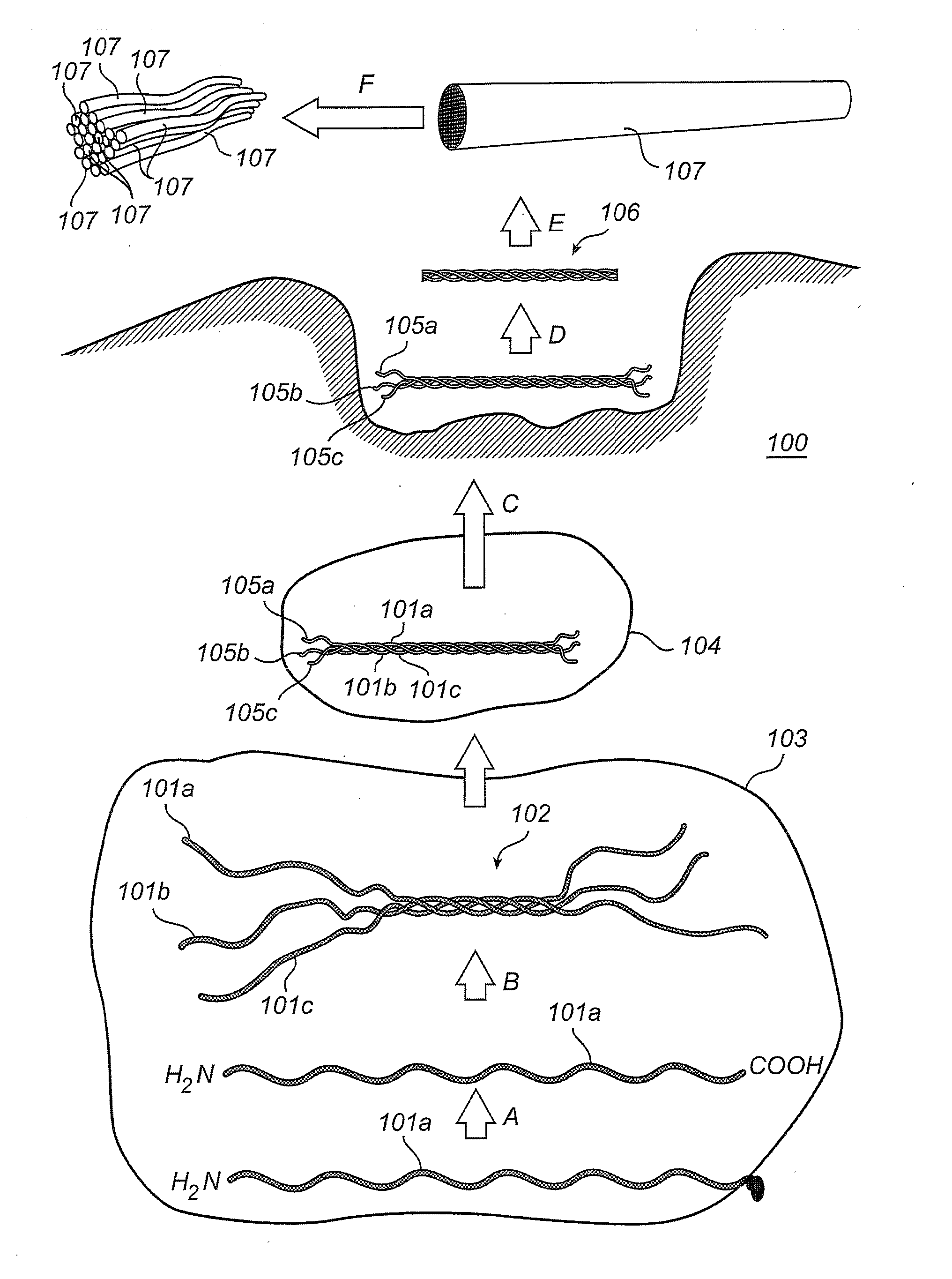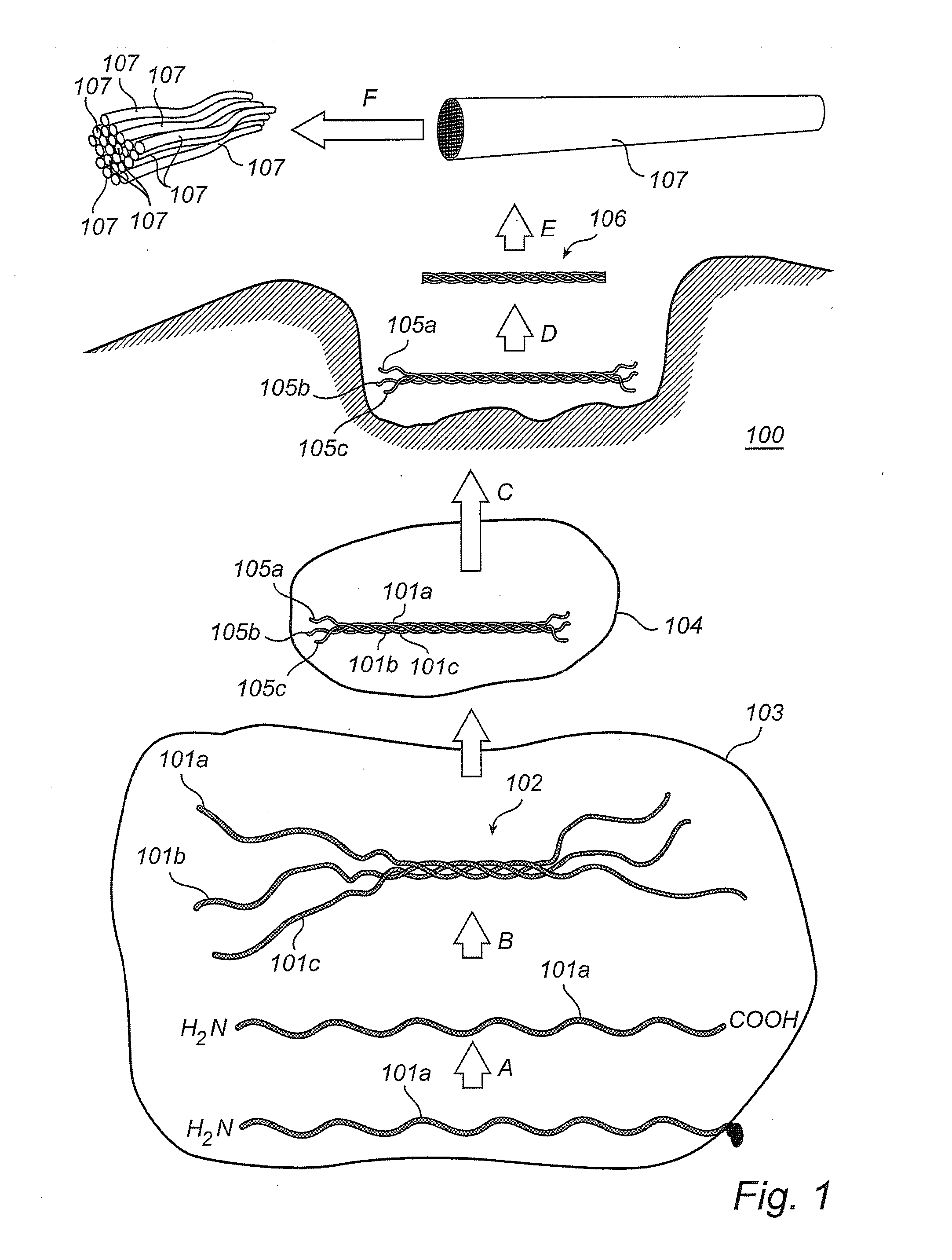Collagen coated article
- Summary
- Abstract
- Description
- Claims
- Application Information
AI Technical Summary
Benefits of technology
Problems solved by technology
Method used
Image
Examples
example 1
Sample Preparation and Characterization
[0109]Commercial pure titanium grade 4 coins with a maximum average roughness Ra of 0.8 μm were cleaned and chemically processed according to a protocol used for commercial dental implants. All coins were rinsed with 97% ethanol and air-dried at room temperature. Coins intended as reference (“Ti”) were processed no further.
[0110]Comparative (“Ti-PLL”) and test (“Ti-PLL-Col”) coins were coated with PLL by applying 150 μl of 0.2 mg / ml poly L-lysine hydrobromide (PLL, 70,000-150,000 g / mol) (obtained from Sigma Aldrich, USA) in MilliQ-water (Millipore, USA) on the surface of the coins, followed by two hours incubation at 60° C., rinsing twice in MilliQ-water and air-drying in room temperature. The comparative (“Ti-PLL”) coins were processed no further.
[0111]After coating with PLL, the test coins (“Ti-PLL-Col”) coins were coated with fibrillar collagen. 150 μl of 0.1 mg / ml equine fibrillar collagen type I solution (Chrono-Log ...
example 2
Cell Compatibility of Surfaces
2.1 Cell Culture
[0120]Human dermal fibroblasts isolated from chronic dermatitis (Hs 483.T (ATCC CRL-7814), LGC Promochem, Sweden), previously passaged four times, were thawed and seeded in a 80 cm2 culture T-flask (Thermo Scientific nunc, USA) with 10 ml of complete growth medium consisting of D-MEM with 100 mM sodium pyruvate and without L-glutamine (PAA Laboratories, Austria), supplemented with 10% fetal bovine serum (FBS) (PAA Laboratories, Austria) and 2 mM L-glutamine (Invitrogen, USA). The medium was changed every third or fourth day and the cells were passaged twice a week. Cells were harvested by trypsinization with trypsin / EDTA (PAA Laboratories, Austria), mixed with 2 ml of FBS and 2 ml of complete growth medium and added with a splitting ratio of 1:2 to 1:3 to a new T-flask containing 10 ml of complete growth medium. Passage numbers represent total passages, thus the first passage in this study is denoted as number five since the cells had pr...
example 3
Surface Compatibility with Osteoblasts
3.1 Sample Surface Preparation
[0138]PLL+collagen fibrill coated discs of commercially pure (c.p.) titanium (“PLL+Coll”) were prepared as described above, Clean uncoated c.p. tianium discs were also used for comparison.
3.2 Cell Culture
[0139]Human palatal mesenchymal cells (HEPM 1486; ATCC) were cultured in Eagles Minimal Essential Media (EMEM) with Earl's Salts with 10% fetal bovine serum (FBS) and Pen / Strep antibiotics [25 mg / ml], and ascorbate [50 mg / ml], NaPyruvate [1 mM], non essential amino acids [0.1 mM], L-glutamine [2 mM], cultured with 5% CO2. Cell culturing entailed isolating HEPM cells via typsin, counting (with a hemocytometer), pelleting and suspension at 50,000 cells / 10 μl. 10 μl of cell suspension (Micromass approach) was plated on each test and control surface, the culture allowed to adhere for 1 hour before gentle flooding with 1 ml of EMEM+10% FBS (Stanford, Jacobson et al, 1995, Journal of Biological Chemistry 270(16):9420-9428...
PUM
| Property | Measurement | Unit |
|---|---|---|
| Temperature | aaaaa | aaaaa |
| Angle | aaaaa | aaaaa |
| Angle | aaaaa | aaaaa |
Abstract
Description
Claims
Application Information
 Login to View More
Login to View More - R&D
- Intellectual Property
- Life Sciences
- Materials
- Tech Scout
- Unparalleled Data Quality
- Higher Quality Content
- 60% Fewer Hallucinations
Browse by: Latest US Patents, China's latest patents, Technical Efficacy Thesaurus, Application Domain, Technology Topic, Popular Technical Reports.
© 2025 PatSnap. All rights reserved.Legal|Privacy policy|Modern Slavery Act Transparency Statement|Sitemap|About US| Contact US: help@patsnap.com



